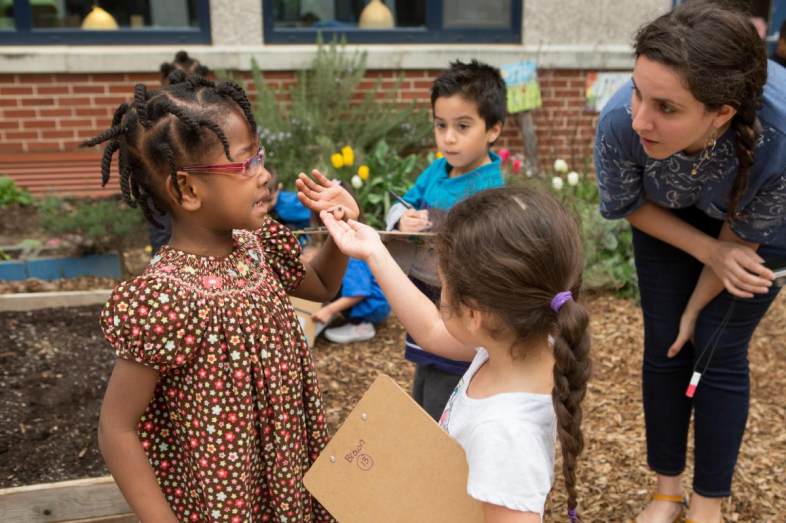
What Reporters Should Look for in Early Learning Settings
Lectures don’t work well for young children. Look instead for child-directed fun.
Photo credit: Allison Shelley for EDUimages
In some classrooms she visited, children counted numbers as they did jumping jacks, author Suzanne Bouffard said. In others, teachers lectured as children sat quietly, nearly whispering answers to questions as if scared to say the wrong thing — something you never want to see a 4-year-old do.
The stark differences among these preschool classrooms illustrate what years of research have documented, Bouffard said.
Related Links
“There’s a huge range of quality in early learning programs. And also there’s a big gap between what we know is best practice and what is actually happening in classrooms,” she said.
But many people—journalists included—don’t realize what they should be looking for when they visit early learning settings, Bouffard said.
Bouffard, whose book “The Most Important Year” examines what good and not-so-good pre-K classrooms look like, and Erikson Institute instructor Angela Searcy shared these and other tips with journalists at the Education Writers Association’s early learning seminar in Chicago Nov. 6 and 7, 2017.
A Learning Opportunity
Forget the idea of a classroom as rows of quiet children at desks scribbling on worksheets, Searcy said. Look instead for classrooms where children have enough space to move around with clearly defined areas for different activities.
Watch how teachers interact with children. Teachers should have conversations with children about what they are doing and ask open-ended questions that encourage students to think.
A conversation with a student playing with blocks can be a learning opportunity, a chance to bring in math, science and literacy, Searcy said.
“Play is just play until we get involved,” she said.
Even the interactions between teachers and very young children can be telling, Searcy said. Teachers should be engaging with infants and toddlers, responding to their babbles and motions.
“When you look at infants, toddlers and 2’s it looks like nothing, but something’s happening,” she said.
Classrooms Should Be Happy
It’s nearly impossible to be a passive observer in an early childhood classroom, Bouffard said. Journalists should capitalize on young children’s openness by asking students about what they’re doing and learning, she said.
“Most of what I learned about the quality of the classroom came from the kids,” she said. “By playing with them I learned a lot about the skills they had and didn’t have.”
Pay attention to the mood and noise level in the classroom too, she said.
“Pre-K classrooms that are doing the right things for children should be happy and have a moderate level of noise,” she said.
Look for children’s work hung on the walls rather than store-bought posters.
Displaying student work is “a really important sign to kids that what they’re doing matters,” she said.
And when visiting a preschool or daycare, “the earlier the better,” she said, since by 11 or 12 o’clock classes have moved into lunch, cleanup and nap.
The Power of Make-believe
Bouffard told journalists to look closely at the roles children play in lessons.
She recalled visiting one classroom where staff were proud of the play center they created where students were supposed to pretend to produce a TV news show. The teachers made a pretend camera from a cardboard box and nametags reading “I am a news anchor” or “I am a weather forecaster” for students to hang around their necks.
But the students at the center, who apparently had little involvement with its creation, were at a loss, puzzled about what exactly they were supposed to do with the teacher-created props.
In another classroom, Bouffard saw a class doing an entire unit on grocery stores. They learned about stores and visited them and then students created their own make-believe grocery store in the classroom. Students in that class eagerly played “store,” taking on the roles of customer and cashier—and learning math, vocabulary and other skills.
“Those kids were so into the grocery store,” Bouffard said.
Work and Play
Early childhood classrooms shouldn’t be all-work or all-play, both presenters said.
“We shouldn’t have to grapple and choose between one or the other. We need both,” Searcy said. “When something’s engaging and fun, you’re learning and retaining a lot of that information.”
Think, for example, about children using blocks to build a ramp for toy cars, Bouffard said. A teacher might take a picture and then ask the children if they can build it even higher.
“Those kids are delighted and they’ve learned something at the same time,” she said.
